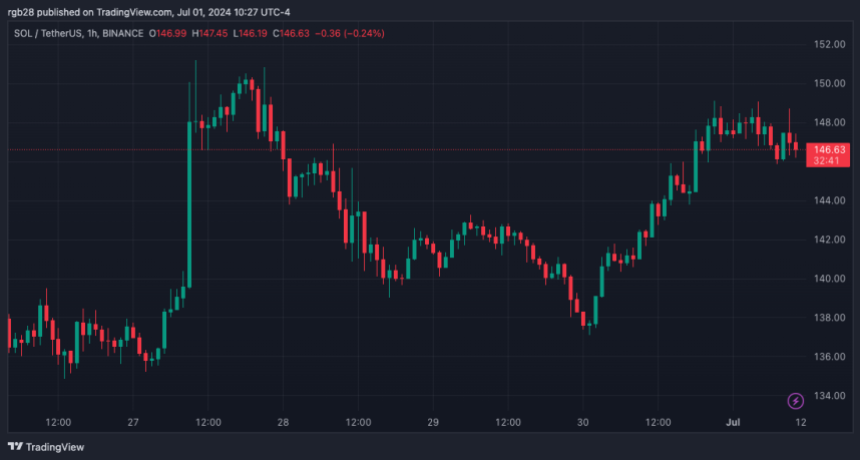Latest News
COPA to seek criminal charges for Craig Wright’s Satoshi ‘lies’ | MATIC News

In the closing stages of the legal case over the identity of Bitcoin’s creator, the Crypto Open Patent Alliance (COPA) said that Craig Wright has failed to establish his claims despite multiple attempts at forgery and should be prosecuted criminally.
COPA’s lawyers said during the closing statement that Wright has perjured himself on multiple counts during the proceedings and submitted documents that are clearly forged.
The lawyers said:
“The audacity of forging an email in the midst of the trial to support his misleading evidence is not only a direct affront to the integrity of the court but also to the foundational principles of justice.”
The organization urged the court to pursue criminal charges against Wright and intends to submit the forged documents to the prosecutor’s office.
Pattern of falsehoods
COPA argued that the evidence clearly shows Dr. Wright did not invent Bitcoin, write the Bitcoin White Paper, or produce the crypto’s code. The team highlighted Wright’s reliance on a vast number of forged documents to support his claim, accusing him of attempting serious fraud against the court.
According to COPA’s lawyers:
“In his quest to substantiate his claim to be Satoshi, Dr. Wright has engaged in the production of a staggering array of forged documents, attempting a serious and elaborate fraud upon the court.”
The closing statements specifically pointed to two incidents that, according to COPA, exemplify Wright’s alleged deceptive tactics.
Firstly, Wright requested a trial adjournment in December, introducing the BDO Drive material and the White Paper LaTeX files as new evidence. COPA claims expert analysis revealed these documents as forgeries created recently, undermining their validity as evidence.
Additionally, COPA accused Wright of forging an email during the trial to support his narrative about the MYOB records, aiming to discredit the accurate account provided by his former solicitors, Ontier. COPA has dismissed Wright’s explanation for this forgery as highly improbable.
Additionally, the lawyers argued that Wright had committed perjury during the proceedings, saying:
“Throughout his testimony, Dr. Wright has engaged in a continuous pattern of falsehoods. There are no bounds to his willingness to deceive, as evidenced by his repeated lies under oath.”
COPA vs. Wright
Wright has claimed to be Bitcoin’s pseudonymous creator, Satoshi Nakamoto, for the better part of a decade and wants to wrest control of the flagship crypto’s development and source code via copyright laws — resulting in COPA filing a lawsuit to disprove his claims.
COPA is seeking injunctive relief to ensure Wright cannot continue to lay claim to Bitcoin’s heritage.
The trial has been going on for several weeks and will continue for a few more days before the UK court can reach a verdict, as both sides have yet to conclude presenting their closing arguments.
COPA, representing a group of crypto developers and stakeholders, challenged Wright’s assertions in court, arguing that his claims were unfounded and supported by a series of forgeries and misleading evidence.
The case spotlighted Wright’s submission of what COPA contends are recently created documents intended to back his claim, including material related to the early development of Bitcoin and alleged communications from the period Satoshi was active.
Mentioned in this article
Latest News
Bahamas to provide CBDC access via commercial banks | MATIC News

The Bahamas will provide access to its central bank digital currency (CDBC) the “Sand Dollar” through commercial banks to increase adoption, Reuters reported on July 1, citing the country’s central bank governor.
Governor of the Central Bank of The Bahamas John Rolle said the country intends to establish the regulations within two years and has started signaling its intent to banks.
Rolle said:
“We foresee a process where all of the commercial banks will eventually be in that space and they will be required to provide their clients with access to the [CBDC].”
The Central Bank of the Bahamas reportedly sees the change as critical to raising CBDC and mobile payment adoption rates, even though banks will need to significantly modify their existing IT systems to comply with the upcoming obligations.
Rolle said uptake of the Sand Dollar is still limited years after its launch in 2020, requiring a shift from incentives to enforcement.
Adoption in question
Reuters described low adoption statistics amid the news. It reported that the CBDC accounts for under 1% of the country’s currency in circulation.
Reuters said wallet top-ups fell to $12 million in the eight months before August 2023 from $49.8 million in the same period in 2022, based on central bank data.
Rolle previously described “wide use, but very low average transaction value” in an interview with The New Times on June 19. He said 120,000 mobile wallets exist, equal to 20% of retail bank accounts, but mobile wallets make up less than 1% of retail payments.
Strong short-term data
A central bank press release from February described stronger short-term data. It recognized “modest seasonal growth in digital payments activities,” including the Sand Dollar, even though lower government transfer payments impacted overall year-to-date trends.
The bank said that the person-to-business (P2B) and business-to-business (B2B) transactions reached a combined $4.5 million, mainly involving the Sand Dollars, doubling from November 2022. It said personal wallet counts rose 20% year-to-date in December 2023. Sand Dollars in circulation rose 60.8% to $1.7 million.
Bahamas’ mandatory adoption policies could precede other strategies elsewhere. Reuters noted that the European Central Bank similarly intends to require retail and banks to accept and offer any future digital euro if it proceeds with one.
Latest News
Polkadot treasury holds $245M but faces revenue decline and two-year runway | MATIC News

The Polkadot Treasury holds assets equivalent to 38 million DOT, worth approximately $245 million. Head Ambassador Tommi Enenkel, popularly known as Alice and Bob, shared a new report providing the latest update on the network’s treasury.
This balance equates to about two years of the runway at its current spending rate. The report stated:
“At the current rate of spending, the Treasury has about two years of runway left, although the volatile nature of crypto-denominated treasuries makes it hard to predict with confidence.”
Polkadot’s first six months of spending
During the first six months of this year, Polkadot invested heavily in its ecosystem, spending 11 million DOT, valued at around $87 million, across various projects.
According to the report, the network invested about $37 million in Outreach activities such as advertisements, sponsorships, and events. The network signed sponsorship deals with race car driver Conor Daly and also pushed several marketing activities designed to bolster the network’s adoption by the broader global community.
Polkadot also spent $23 million developing its network features and upgrades, including SDK, Data Services and Indexing, Governance, and Subwallets.
Moreover, the network invested $15 million in liquidity incentives and $5.5 million in Talent and Education. Additionally, it spent $3.8 million to maintain the network and core ecosystem components, and another $2.1 million went towards Research.
Revenue decline
The report highlighted a decline in Polkadot’s revenue. During the first six months of the year, the network’s total earnings dropped to 171,696 DOT from 414,291 DOT, recorded in the second half of 2023.
Enenkel attributed this decline to the significant drop in network fees, which fell from 313,443 DOT last year to 39,444 DOT in the 2024 first half:
“We see that direct revenue from fees is still marginal. Polkadot made 300k DOT from fees in 2023-H2 from a short-lived inscriptions campaign. Fees under regular conditions are pretty stable with about 20k DOT per quarter. Other sources of revenue are typically transfers from accounts that return funds that they received and pay them back for various reasons.”
Disclaimer: CryptoSlate has received a grant from the Polkadot Foundation to produce content about the Polkadot ecosystem. While the Foundation supports our coverage, we maintain full editorial independence and control over the content we publish.
Latest News
Vitalik Buterin suggests ways to speed up Ethereum transaction confirmations | MATIC News

Ethereum co-founder Vitalik Buterin has suggested ways to help the blockchain improve its transaction confirmation times.
Buterin, in a June 30 blog post, explained that Ethereum’s Gasper consensus mechanism uses a slot-and-epoch architecture that contains certain complexities, like bug interactions and a 12.8-minute confirmation time, that makes it “more and more uncomfortable” for user experiences.
So, he highlighted some of the “practical options” Ethereum has to improve its user experience further.
SSF
Buterin stated that the single-slot finality (SSF) mechanism is similar to the Tendermint consensus, as it allows the finalization of blocks as soon as they are produced.
However, unlike the Tendermint consensus, Ethereum will keep the “inactivity leak” mechanism to allow chains to remain functional even if a third of the validators go offline. Buterin added that the single-slot finality mechanism also has its faults. Notably, all Ethereum stakers must publish two messages every 12 seconds, overloading the chain.
Meanwhile, Buterin furthered that while there are ideas to mitigate this issue, users may still have to wait 5-20 seconds. He wrote:
“There are clever ideas for how to mitigate this, including the very recent Orbit SSF proposal. But even still, while this improves UX significantly by making ‘finality’ come faster, it doesn’t change the fact that users need to wait 5-20 seconds.”
Rollup preconfirmations
Rollup preconfirmations aim to improve Ethereum’s Layer 2 (L2) solutions. These solutions process transactions with the same security as the Ethereum base layer (L1) but on a larger scale.
Rollups confirm transactions much faster than the current 5-20 seconds, targeting latencies of hundreds of milliseconds. This method divides responsibilities — the L1 network remains stable, censorship-resistant, and reliable, while the L2s offer faster transaction times and address user needs directly.
To achieve faster confirmations, L2s create decentralized sequencing networks. These networks have smaller groups of validators who quickly sign off on blocks, often within milliseconds, and commit them to the blockchain.
However, validators must ensure their commitments are consistent and trustworthy. If a validator signs conflicting blocks, they risk losing their deposits.
Based preconfirmations
Based preconfirmations leverage Ethereum proposers’ advanced capabilities, driven by Maximum Extractable Value (MEV) prospects.
The concept involves establishing a standardized protocol where users can pay an extra fee for immediate assurance that their transaction will be included in the upcoming block. This service, known as preconfirmations-as-a-service, would assure users of swift transaction confirmation.
Proposers who fail to fulfill their commitment or breach the agreement face penalties (slashing). Buterin noted that this framework will apply to L1 transactions and extend to L2 solutions. By treating all L2 blocks as L1 transactions, the preconfirmation mechanism ensures accelerated confirmations throughout the Ethereum network.
Buterin noted that Ethereum implementing SSF and rollup or based preconfirmations could significantly reduce transaction confirmation times.
However, he pointed out that this would return to the initial “epoch-and-slot architecture” the blockchain was trying to ditch. He stated:
“There is a deep philosophical reason why epoch-and-slot architectures seem to be so hard to avoid: it inherently takes less time to come to approximate agreement on something, than to come to maximally-hardened ‘economic finality’ agreement on it.”
He suggested that the network developers explore other options that are not as tightly interwoven as Gasper.
Mentioned in this article
-

 Hot Projects4 months ago
Hot Projects4 months agoBitcoin Blasts Past $70,000 to Register New All-Time High | MATIC News
-

 Latest News4 months ago
Latest News4 months agoCourt upholds SEC’s unregistered securities claims against Gemini, Genesis’ Earn program | MATIC News
-

 Latest News2 months ago
Latest News2 months agoSix Coinbase customers claim the exchange is violating securities laws in new lawsuit | MATIC News
-
Hot Projects2 months ago
Bitcoin Will Be Set For New ATHs If It Breaks This Resistance: Analyst | MATIC News
-

 Hot Projects3 months ago
Hot Projects3 months agoBitcoin ETF Inflows Could Eclipse $1 Trillion, Predicts Bitwise CIO | MATIC News
-

 Hot Projects3 months ago
Hot Projects3 months agoOndo Finance Joins BlackRock Tokenized Fund As Inflows Surpass $160M | MATIC News
-

 Latest News4 months ago
Latest News4 months agoOver $1 billion wiped off HEX’s valuation following Richard Heart’s disparaging remarks | MATIC News
-

 Hot Projects2 months ago
Hot Projects2 months agoPEPE Whales Go On Massive 720B Shopping Spree Amid Campaign For New ATHs, Is It Time To Get In? | MATIC News




